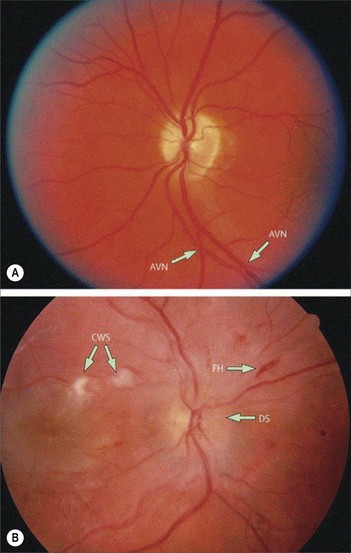202 Hypertensive retinopathy
Salient features
Advanced-level questions
How would you grade hypertensive retinopathy?
Keith–Wagener–Barker classification
This combines the clinical findings of hypertension and atherosclerosis:
Mention a few causes of hypertension
What is the relationship between morbidity and hypertensive retinopathy?
Neurological link
• In a 3-year population-based cohort study of atherosclerosis risk, incident stroke events were more common in participants with signs of hypertensive retinopathy than in participants without retinopathy. When controlled for BP, diabetes, lipids and other risk factors, moderate signs of hypertensive retinopathy (cotton-wool spots, retinal haemorrhages and microaneurysms) were associated with a two- to four-fold higher risk of incident stroke. Weaker associations between signs of mild hypertensive retinopathy and risk of stroke were also present (Lancet 2001; 358:1134–40).
• Hypertensive retinopathy is also reported to be associated with cognitive decline, cerebral white-matter lesions identified by cerebral MRI, lacunar infarctions, cerebral atrophy and stroke mortality.
Cardiovascular link
• Studies of the association between hypertensive retinopathy signs and heart disease have produced inconsistent results. However, hypertensive retinopathy has been linked with coronary artery stenosis and with incident coronary heart disease events.
• Some investigators suggest that moderate hypertensive retinopathy could be used to predict incident congestive heart failure, even in individuals without a previous history of myocardial infarction.
Ahmed ME, Walker JM, Beevers DG, Beevers M. Lack of difference between malignant and accelerated hypertension. BMJ. 1986;292:235-237.
Dollery CT, Ramalho PS, Patterson JW, et al. Retinal microemboli: experimental production of ‘cottonwool’ spots. Lancet. 1965;i:303.
Keith NM, Wagner HP, Barker NW. Some different types of essential hypertension: their course and prognosis. Am J Med Sci. 1939;197:332-343.







